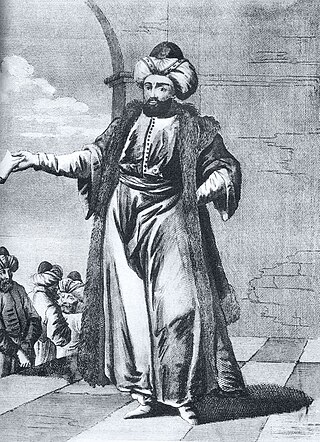
The Beylik of Tunis was a de facto independent state located in present-day Tunisia, formally part of the Ottoman Empire. It was ruled by the Husainid dynasty from 1705 until the establishment of the French protectorate of Tunisia in 1881. The term beylik refers to the monarch, who was called the Bey of Tunis. Under the protectorate, the institution of the Beylik was retained nominally, with the Husainids remaining as largely symbolic sovereigns.

Abu l-Hasan Ali I, also known as Ali Bash or Ali Bey I,) was the second leader of the Husainid Dynasty and the ruler of Tunisia from 1735 to 1756.

Mohamed Bey El Mouradi was a Muradid leader and Bey of Tunis from 1675 until his death in 1696. He was the eldest son of Murad II Bey.

Ottoman Tunisia, also known as the Regency of Tunis, refers to the Ottoman presence in Ifriqiya from the 16th to 19th centuries, when Tunis was officially integrated into the Ottoman Empire as the Eyalet of Tunis. The Ottoman presence in the Maghreb began with the takeover of Algiers in 1516 by the Ottoman Turkish corsair and beylerbey Aruj, eventually expanding across the entire region except for Morocco. The first Ottoman conquest of Tunis occurred in 1534 under the command of Khayr al-Din Barbarossa, the younger brother of Aruj, who was the Kapudan Pasha of the Ottoman Fleet during the reign of Suleiman the Magnificent. However, it was not until the final Ottoman reconquest of Tunis from Spain in 1574 that the Turks permanently acquired the former territories of Hafsid Tunisia, retaining it until the French occupation of Tunisia in 1881.

The Revolutions of Tunis or the Muradid War of Succession was a period of troubles and civil wars in Ottoman Tunisia. It ran from the death of the Muradid sovereign Murad II Bey in 1675 until the seizure of power by the Husainid sovereign Al-Husayn I ibn Ali at-Turki in 1705. The belligerents were Ali Bey al-Muradi and Muhammad Bey al-Muradi, their uncle Muhammad al-Hafsi al-Muradi, several Deys of Tunis, the Turkish militia in Tunis and the Dey of Algiers.
Ibrahim Sharif was Bey of Tunis from 1702 to 1705, during the revolutions of Tunis, a period of crisis which brought an end to the Muradid dynasty and preceded the rise to power of Husayn I Bey.
Madrasa Al Husseiniya Al Sughra or the Small Husainid Madrasa is a tunisian madrasah in the Medina of Tunis.

Baba Ali Chaouch, also known as Ali Soukali, or simply Ali I, was a ruler of the Deylik of Algiers from 1710 to 1718. He was the first dey of Algiers to be invested with the title of dey-pacha. The Sultan Ahmed III had Ali Chaouch's envoy given the caftan and the three tails, a sign of the dignity of a "pasha". This title was attributed to all his successors until 1830.
Hammadi Hamida Sammoud is a Tunisian academic, writer, historian, and linguist, who was born on June 25, 1946. He is also a member of the House of Wisdom Foundation.

The Beylik of the West was one of three Beyliks (governorates) of the Regency of Algiers, with the other two being the Beylik of Titteri and the Beylik of Constantine. It was established in 1563, and it was ended during the French conquest.

The Tunisian–Algerian war of 1694 was a conflict between the Deylik of Algiers, and the Regency of Tunis.
The Maghrebi war (1699–1702) was a conflict involving a Tunisian, Tripolitanian, and Moroccan coalition, and the Deylik of Algiers. It was an important milestone in the further weakening of the already fragile Ottoman grip over the Maghreb, as both sides utterly ignored the Ottoman sultan's pleas to sign a peace treaty. This war also led to the renewal of the Muradid infighting, which would later lead to the establishment of the Beylik of Tunis, and the Husainid dynasty in 1705.
The siege of Tunis was a siege fought in 1694, between the Deylik of Algiers, and Muradid Tunis, during the Tunisian-Algerian War of 1694.
The Constantine campaign was launched by Bey of Tunis Murad III Bey in 1699 to capture the Beylik of Constantine, situated in the east of the Deylik of Algiers.
The Capture of Tunis was a military operation led by the Bey of Constantine during which he seized Tunis and made the Beylik of Tunis a tributary of Algiers.

Hassan Husni bin Saleh bin Abd al-Wahhab bin Yusuf Al-Samadhi Al-Tujibi. He was born in Tunis, on Monday 27 Ramadan 1301 AH / 21 July 1884 AD, and died there on Saturday 18 Sha’ban 1388 AH / 9 November 1968 AD. a Tunisian writer, linguist and historian, his name is compound: Hassan Husni.

The Tunisian–Algerian War of 1807 was a conflict between the Beylik of Tunis and the Deylik of Algiers. The war led to the emancipation of Tunisia from any sort of Algerian influence, and the ending of the tribute paid by Tunisia to Algeria since 1756.
The Tunisian–Algerian War of 1705 was a conflict between the Regency of Algiers and the Regency of Tunis.
The Battle of Majaz al-Bab was a battle between Tunis and Algiers in 1705 which ended in an Algerian defeat.
Algerian Invasion of Tunis (1705) was a conflict between Algiers and Tunis. The algerians attacked tunis to finish the Husinid dynasty but they lost the war and went back to algeria









